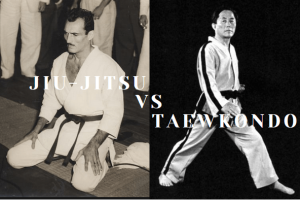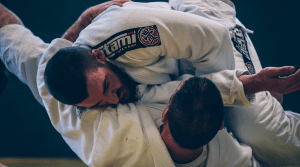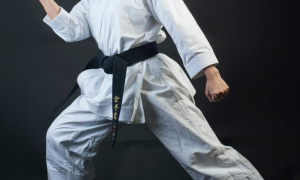
When venturing into the world of martial arts, the choices can seem overwhelming, and two prominent disciplines that often stand at the forefront are Taekwondo Vs Jiu-Jitsu. If you find yourself pondering the difference between Taekwondo and Jiu Jitsu, seeking to answer questions like “Is Jiu Jitsu better than Taekwondo?” or “What’s the difference between Taekwondo and Jiu Jitsu?”, you’re not alone. The distinct philosophies, techniques, and self-defense approaches of these martial arts can make the decision daunting, but fear not! We’re here to provide you with a comprehensive comparison to help you make an informed choice for your martial arts journey.
Taekwondo, a dynamic and explosive stand-up striking art, and Brazilian Jiu Jitsu (BJJ), a ground-based grappling martial art, are both highly respected and offer unique benefits. Throughout this article, we will delve into their origins, philosophies, and fundamental techniques to illuminate the contrast between Taekwondo and Jiu Jitsu. Whether you’re a beginner looking to take your first step into the world of martial arts or a practitioner seeking to broaden your skills, understanding the differences and similarities between Taekwondo and Jiu Jitsu will guide you on your path to personal growth and self-defense mastery.
Table of Contents
Toggle![]()
Taekwondo Vs Jiu-Jitsu: A breakdown of Jiu-Jitsu as a martial art

![]()
Origin
Brazilian Jiu-Jitsu, often referred to as BJJ, traces its roots back to Japan in the 15th century. Originally known as “Ju-Jitsu,” it was developed as a battlefield art for the samurai to defend themselves when unarmed in combat. Over time, various schools and styles of Jiu-Jitsu emerged, each emphasizing different techniques. However, it was Brazilian Jiu-Jitsu that gained international recognition and popularity, thanks to the efforts of the Gracie family.
History
The Gracie family, particularly Helio Gracie, played a pivotal role in shaping Brazilian Jiu-Jitsu as we know it today. In the early 20th century, Helio Gracie refined the techniques of Jiu-Jitsu to suit his smaller stature and weaker physique. This adaptation led to the creation of a highly effective ground-fighting system focused on leverage and technique rather than brute strength.
Rorion Gracie later helped found the Ultimate Fighting Championship (UFC) to showcase the effectiveness of Brazilian Jiu-Jitsu in mixed martial arts (MMA) competitions. This move revolutionized the martial arts landscape, catapulting BJJ to global recognition and establishing it as a core discipline in MMA.
Philosophy
Beyond being a means of self-defense, Brazilian Jiu-Jitsu embodies a philosophy that extends beyond the mats. BJJ emphasizes camaraderie and community, fostering a sense of brotherhood among practitioners regardless of background or language. Humility is a key aspect of the BJJ journey, as students start of feeling helpless during their beginnings but gradually develop respect for others’ abilities.
Empathy and selflessness are ingrained in the BJJ ethos, encouraging practitioners to understand and support their training partners. The spirit of BJJ is about helping others grow and improve together, creating a strong sense of unity within the community.
Techniques
Brazilian Jiu-Jitsu is primarily a ground-fighting martial art, with a focus on submissions, joint locks, and strangulations. Some of the main techniques include:
- Joint Locks: BJJ practitioners learn a variety of joint locks, such as arm-bars, kimura, americana (keylock), shoulder locks, and foot locks, to control and submit opponents.
- Strangulations: Choke holds, such as the rear naked choke (RNC), guillotine choke, triangle choke, arm triangle, and lapel chokes (if wearing a gi), are essential techniques to force an opponent to submit.
- Takedowns/Throws: BJJ incorporates wrestling and judo-based techniques to take an opponent down to the ground and gain control from various positions.
While Brazilian Jiu-Jitsu has some striking techniques, they are usually taught separately in disciplines like Muay Thai or MMA. The emphasis remains on ground control and submission grappling, making BJJ a formidable art in close-quarters combat.
![]()
Taekwondo vs Jiu-Jitsu: A breakdown of Taekwondo as a martial art

![]()
Origin
Taekwondo, the national martial art of Korea, has deep historical roots dating back centuries. Ancient Korean kingdoms utilized self-defense systems with techniques similar to those seen in modern-day Taekwondo. However, it wasn’t until the mid-20th century that Taekwondo began to take its current form.
History
After Korea gained independence from Japan at the end of World War II, Taekwondo started to flourish. It owes its modern development to pioneers like Choi Hong-hi and Nam Tae-hi, who demonstrated the art to South Korean President Syngman Rhee in 1952. The official establishment of the Korea Taekwondo Association and the formation of the World Taekwondo Federation in 1973 further propelled the art’s popularity worldwide.
Philosophy
Taekwondo instills a strong moral foundation in its practitioners through its five tenets: Courtesy (Ye-ui), Integrity (Yeom-chi), Perseverance (In-nae), Self-Control (Geuk-gi), and Indomitable Spirit (Baek-jeol-bul-gul). These principles guide practitioners not only in the dojang (training hall) but also in their everyday lives.
Respect and courtesy towards others are central to Taekwondo, promoting a harmonious and disciplined environment for learning and personal growth. Practitioners are encouraged to uphold integrity by standing up for what is right and fair.
Perseverance in training, coupled with self-control in physical and mental actions, enables practitioners to overcome challenges and achieve their goals. Finally, the indomitable spirit cultivates determination and courage, empowering Taekwondo practitioners to face adversity with unwavering resolve.
Techniques
Taekwondo is a striking martial art that focuses on high-speed kicks, dynamic punches, and evasive footwork. Some of the key techniques include:
- Sidekicks/Front Kicks: Sidekicks and front kicks are used to maintain distance and strike opponents from a range.
- Punches: Taekwondo practitioners utilize straight punches and various hand strikes to set up their kicks.
- Roundhouses: Snapping kicks to the side of an opponent’s face or body are powerful tools in Taekwondo.
- Spinning/Jumping Kicks: Advanced techniques like spinning and jumping kicks deliver devastating attacks with incredible speed and force.
Taekwondo competitions award points based on the successful execution of these techniques to the torso and head of an opponent. It is a discipline that requires precision, agility, and speed to score effectively.
![]()
The Difference in Techniques between Taekwondo Vs Jiu-Jitsu
![]()
Both Brazilian Jiu-Jitsu and Taekwondo are respected martial arts, but their techniques and approaches to combat are fundamentally distinct. Understanding these differences is essential in determining which art aligns better with individual goals and preferences.
Brazilian Jiu-Jitsu Techniques
Brazilian Jiu-Jitsu is a grappling-based martial art that primarily focuses on ground fighting. Practitioners aim to take the fight to the ground and utilize leverage and technique to control and submit opponents. BJJ techniques include:
- Joint Locks: BJJ practitioners apply various joint locks, targeting the arms, legs, and shoulders, to immobilize and force an opponent to submit.
- Strangulations: Choke holds, such as rear naked chokes and guillotine chokes, are crucial techniques in BJJ, rendering an opponent unconscious or forcing them to concede.
- Takedowns and Throws: BJJ incorporates techniques from judo and wrestling to take an opponent down to the ground and gain advantageous positions.
Here is an example of a Jiu-Jitsu arm bar.
Taekwondo Techniques
Taekwondo, on the other hand, is a striking martial art that emphasizes high-speed kicks, punches, and evasive footwork. The techniques in Taekwondo include:
- Kicks: Taekwondo practitioners execute various kicks, such as roundhouses, sidekicks, and jumping kicks, targeting the head and torso of the opponent.
- Punches: Straight punches and hand strikes complement the kicking techniques, setting up combinations and creating openings for kicks.
- Footwork and Evasion: Taekwondo practitioners employ agile footwork and evasive maneuvers to avoid opponents’ attacks and maintain distance.
Here is an example of a Taekwondo roundhouse kick.
Contrasting Approaches
The fundamental contrast lies in the range at which these martial arts operate. BJJ excels in close-quarters combat and ground control, where grappling techniques come into play. In contrast, Taekwondo thrives in stand-up striking range, utilizing swift and powerful kicks to create distance and strike opponents from afar.
In a self-defense scenario, Brazilian Jiu-Jitsu proves effective when the fight goes to the ground. It empowers practitioners, regardless of size and strength, to neutralize larger opponents using leverage and technique. Taekwondo, on the other hand, is more suitable for defending against standing attacks, utilizing its dynamic kicks to deter and disable assailants.
Complementary Nature
Despite their differences, these martial arts can complement each other in a well-rounded self-defense skillset. Integrating both disciplines enables a practitioner to handle a variety of situations, whether the encounter remains on the feet or transitions to the ground. Such versatility can be particularly beneficial in real-life scenarios, where attacks are unpredictable.
Many martial artists (such as UFC commentator Joe Rogan) choose to cross-train in both Brazilian Jiu-Jitsu and Taekwondo to broaden their skillset and improve their overall proficiency in combat. However, the decision ultimately depends on individual goals and preferences, as each art offers unique benefits and challenges.
![]()
Similarities: Taekwondo Vs Jiu-Jitsu
![]()
While Brazilian Jiu-Jitsu and Taekwondo differ significantly in their techniques and approach to combat, they also share some similarities. These common aspects contribute to the overall growth and development of practitioners in both martial arts.
Discipline and Focus
Both Brazilian Jiu-Jitsu and Taekwondo emphasize discipline and mental focus. Practitioners of both arts must devote themselves to rigorous training, adhere to a code of conduct, and exhibit respect towards their instructors and training partners. The cultivation of mental fortitude is crucial in mastering the techniques and achieving proficiency in either martial art.
Physical Fitness
Both BJJ and Taekwondo place a strong emphasis on physical fitness. Training sessions involve a combination of cardiovascular exercises, strength training, and flexibility exercises, contributing to improved overall health and conditioning. Additionally, practitioners benefit from enhanced body coordination and control, which are essential for executing precise techniques in each art.
Belt Ranking System
Both Brazilian Jiu-Jitsu and Taekwondo utilize a colored belt ranking system to signify a practitioner’s level of skill and experience. Starting as a white belt, students progress through various colored belts until they attain the coveted black belt. The belt system not only motivates practitioners to set and achieve goals but also serves as a means of tracking their progress in the respective martial arts.
Learn more about the Taekwondo and Jiu-Jitsu Belt systems in our articles.
Self-Defense Applications
While Taekwondo is more striking-oriented and Brazilian Jiu-Jitsu focuses on grappling, both arts include self-defense techniques that can be effective in real-life situations. Taekwondo practitioners learn to defend themselves against standing attacks, while BJJ practitioners gain the ability to control and submit opponents on the ground, even in potentially dangerous situations.
Character Development
Both Brazilian Jiu-Jitsu and Taekwondo foster positive character development in their practitioners. Through the rigorous training and challenging learning process, individuals in both arts develop qualities such as perseverance, humility, and respect for others. These attributes extend beyond the martial arts training, positively impacting various aspects of practitioners’ lives.
![]()
Differences: Taekwondo Vs Jiu-Jitsu
![]()
While Brazilian Jiu-Jitsu and Taekwondo share some similarities, they are fundamentally different in their techniques, training methodologies, and overall approach to combat. These differences shape the unique characteristics of each martial art and attract practitioners with distinct preferences and goals.
Fighting Range and Techniques
One of the most apparent differences between Brazilian Jiu-Jitsu and Taekwondo lies in their fighting range and techniques. Taekwondo is a stand-up striking art that focuses on powerful kicks, fast punches, and dynamic footwork. It emphasizes maintaining distance to utilize the full reach of kicks and punches effectively. On the other hand, Brazilian Jiu-Jitsu is primarily a ground-fighting art that revolves around grappling, submissions, and controlling opponents on the ground. BJJ practitioners seek to take the fight to the ground where they can utilize their techniques to dominate opponents.
Sport vs. Self-Defense
While both martial arts have applications in self-defense scenarios, their primary focus differs. Taekwondo is often practiced as a sport with competitive sparring involving kicks and punches to score points. The emphasis is on delivering strikes to the opponent’s torso or head to secure victory. Brazilian Jiu-Jitsu, while also having a sportive aspect with points-based competition, places greater emphasis on practical self-defense applications, particularly in ground fighting situations. BJJ practitioners learn how to control and subdue opponents without causing significant harm, making it effective for self-defense, especially in close-quarters encounters.
Training Intensity and Approach
The training intensity and approach in Brazilian Jiu-Jitsu and Taekwondo can differ significantly. BJJ practitioners often engage in intense sparring, referred to as “rolling,” from early stages of training. This live, resistance-based training is essential for developing practical skills and applying techniques against fully resisting opponents. In contrast, Taekwondo training, especially in the early stages, may involve more controlled sparring and forms practice. The emphasis on proper form and technique is prevalent in Taekwondo training, with full-contact sparring often introduced at later stages.
Philosophy and Values
Each martial art carries its unique philosophy and set of values. Brazilian Jiu-Jitsu emphasizes humility, patience, and the concept that technique can overcome strength, allowing smaller practitioners to overcome larger opponents. It fosters a strong sense of camaraderie and respect among training partners, creating a tight-knit community. Taekwondo, on the other hand, emphasizes the five tenets of courtesy, integrity, perseverance, self-control, and indomitable spirit. These values shape the character of practitioners and guide their behavior both inside and outside the training environment.
Belt Ranking System
While both arts employ a belt ranking system, the specifics of their systems differ. Brazilian Jiu-Jitsu has a more extensive and demanding progression system with 10 years being the expected time to achieve a BJJ Black Belt. In contrast, Taekwondo generally follows a faster belt system, progressing from white to Taekwondo black belt takes approximately 5 years, with additional degrees of black belt denoting higher levels requiring much longer.

![]()
Pros and Cons: Taekwondo Vs Jiu-Jitsu
![]()
Both Brazilian Jiu-Jitsu and Taekwondo have their strengths and weaknesses, which make them suitable for different individuals and goals. Let’s explore the pros and cons of each martial art:
Pros of Taekwondo and Jiu-Jitsu
Brazilian Jiu-Jitsu Pros:
- Highly effective for self-defense in close-quarters and ground-fighting situations.
- Teaches practitioners how to defend against larger and stronger opponents using leverage and technique.
- Fosters a strong sense of community and camaraderie among practitioners.
- Develops mental resilience, patience, and problem-solving skills through intense sparring.
- Offers a practical and effective system for neutralizing and subduing aggressors without causing severe harm.
- Great for building overall physical fitness, flexibility, and body awareness.
Taekwondo Pros:
- Exceptional for developing kicking techniques and flexibility.
- Focuses on long-range striking, enabling practitioners to keep opponents at a distance.
- Emphasizes self-discipline, courtesy, and respect, instilling valuable life values.
- Offers excellent cardiovascular and aerobic conditioning.
- Encourages competition and provides opportunities for sporting achievements.
- Promotes mental focus and concentration through patterns (forms) practice.
Cons of Taekwondo and Jiu-Jitsu
Brazilian Jiu-Jitsu Cons:
- Lacks emphasis on striking techniques and long-range combat.
- May require a longer learning curve to become proficient in ground techniques.
- Training may lead to potential injuries, especially during improper sparring.
- Fewer opportunities for competitive achievements compared to striking-based martial arts.
Taekwondo Cons:
- Limited focus on ground-fighting and grappling, leaving practitioners vulnerable in close-quarters situations.
- High focus on kicking may not be practical in certain self-defense scenarios.
- Limited clinching techniques and takedown defense skills.
- Striking techniques may not be as effective against larger or more skilled opponents.
![]()
Which One is Better in Self-Defense? Taekwondo Vs Jiu-Jitsu
![]()
The age-old debate of which martial art is superior for self-defense, Brazilian Jiu-Jitsu or Taekwondo, often leads to intriguing discussions among practitioners and enthusiasts. Let’s delve into the factors that make each martial art effective for self-defense:
Brazilian Jiu-Jitsu for Self-Defense:
Brazilian Jiu-Jitsu is highly regarded as one of the most effective martial arts for self-defense, especially in real-life scenarios where the fight might end up on the ground. BJJ’s focus on ground-fighting and submissions allows practitioners to control and neutralize attackers without causing severe harm. This is particularly advantageous in situations where the attacker is larger or stronger.
Key Advantages of BJJ in Self-Defense:
- Ground Control:
BJJ practitioners are trained to take the fight to the ground, where they can use leverage and technique to control and submit their opponents effectively. - Submissions:
BJJ teaches various submissions such as chokes and joint locks, allowing practitioners to neutralize attackers without causing long-term injuries. - Escapes:
BJJ emphasizes escape techniques from disadvantageous positions, helping practitioners get out of dangerous situations. - Versatility:
BJJ’s focus on practical sparring prepares individuals to handle the chaos and stress of a real fight. - Size and Strength Neutrality:
BJJ’s emphasis on technique over athleticism enables smaller individuals to defend themselves against larger and stronger assailants.
Taekwondo for Self-Defense:
Taekwondo’s strengths lie in its dynamic kicking techniques and long-range strikes, making it effective in stand-up scenarios. While it may not offer as many tools for ground-fighting, Taekwondo’s emphasis on striking can be valuable in certain self-defense situations.
Key Advantages of Taekwondo in Self-Defense:
- Range Management:
Taekwondo practitioners are skilled in keeping opponents at a distance with their powerful kicks, reducing the risk of getting grabbed or tackled. - Striking Power:
Taekwondo kicks, especially head kicks, can deliver devastating blows to attackers, potentially ending the confrontation quickly. - Mental Discipline:
Taekwondo’s focus on discipline and respect can help practitioners remain composed and make better decisions in tense situations. - Mobility and Agility:
Taekwondo training enhances footwork and agility, aiding practitioners in evading threats and creating opportunities for counter-attacks. - Confidence:
Learning effective striking techniques can boost self-confidence and make individuals feel more secure in dangerous situations.
Conclusion: Choosing the Right Martial Art for Self-Defense
The decision of whether to pursue Brazilian Jiu-Jitsu or Taekwondo for self-defense ultimately depends on individual preferences, physical abilities, and the potential threats one might face. Both martial arts offer valuable skills, and the choice should align with personal goals and comfort levels.
For those seeking a comprehensive self-defense system with a strong focus on ground-fighting and submissions, Brazilian Jiu-Jitsu might be the preferred choice. On the other hand, individuals looking for striking-based techniques and powerful kicks for stand-up scenarios might find Taekwondo more appealing.
Ultimately, the most effective self-defense comes from a combination of skills from different martial arts and a commitment to continuous learning and practice. Additionally, understanding basic self-defense principles, situational awareness, and de-escalation techniques are crucial aspects of protecting oneself in real-world situations.
![]()
Which One is Better in a Street Fight? Taekwondo Vs Jiu-Jitsu
![]()
When it comes to street fights, the dynamics and unpredictability of real-life altercations present unique challenges. Let’s examine how Brazilian Jiu-Jitsu and Taekwondo fare in a street fight scenario:
Brazilian Jiu-Jitsu in Street Fights:
Brazilian Jiu-Jitsu has proven its effectiveness in street fights due to its focus on practical grappling techniques and ability to control opponents without causing excessive harm. In a self-defense situation on the street, BJJ practitioners have several advantages:
- Ground Control: Street fights can quickly escalate to the ground, where BJJ shines. Practitioners can use takedowns and leverage to control and neutralize attackers without resorting to striking.
- Subduing Without Injury: In a street fight, the goal is to protect oneself while minimizing harm to the attacker. BJJ offers a wide range of submission holds and chokes that allow practitioners to end the fight without causing severe injuries.
- Multiple Opponents: In real-life scenarios, facing multiple attackers is a possibility. BJJ’s grappling skills enable practitioners to focus on one opponent at a time, controlling them while minimizing exposure to other attackers.
- Self-Defense Mindset: BJJ training emphasizes situational awareness and teaches practitioners to remain calm and focused during high-stress situations, critical attributes in street fights.
- Escapes and Defense from Bottom: If taken to the ground, BJJ practitioners are trained to defend themselves effectively even from inferior positions, which is essential in street fights.
Taekwondo in Street Fights:
Taekwondo’s effectiveness in street fights relies heavily on maintaining distance and using powerful kicks for self-defense. While it may not have the grappling emphasis of BJJ, Taekwondo has its advantages in certain street fight situations:
- Kicking Range: Taekwondo’s arsenal of high kicks allows practitioners to keep attackers at a distance, reducing the risk of being grabbed or overpowered.
- Surprise and Impact: A well-executed Taekwondo kick, especially to the head, can deliver a powerful blow and potentially incapacitate an attacker.
- Defensive Footwork: Taekwondo training emphasizes footwork, agility, and evasion techniques, allowing practitioners to move away from threats and avoid confrontations.
- Confidence and Presence: Taekwondo’s focus on mental discipline can instill confidence in practitioners, deterring potential attackers or de-escalating situations.
Street Fight Considerations: In a street fight, various factors come into play that can impact the effectiveness of any martial art. These include:
- Multiple Attackers: Street fights can involve more than one assailant, making it crucial to prioritize survival and escape over engaging in lengthy confrontations.
- Environment: The terrain and surroundings in a street fight may be unpredictable and uneven, affecting the effectiveness of certain techniques.
- Weapon Possibility: In street fights, attackers may be armed with weapons, adding a new level of danger and complexity to the situation.
Conclusion: Taekwondo Vs Jiu-Jitsu – Street Fight Effectiveness
While both Brazilian Jiu-Jitsu and Taekwondo have strengths that can be valuable in street fights, BJJ edges out ahead of Taekwondo due to its superior ground work. The outcome of a street fight depends on various factors, including the skills, mindset, and adaptability of the practitioner, as well as the specific circumstances of the encounter. However the majority of street fights end up on the ground which makes BJJ a more effective martial art than Taekwondo when dealing with street fights.
Ultimately, self-defense training should not be limited to a single martial art. A well-rounded approach that incorporates techniques from multiple disciplines, along with situational awareness and conflict de-escalation skills, can provide individuals with a more comprehensive toolkit to stay safe in real-life situations. We have also given in depth comparison on Taekwondo vs Capoeira and Taekwondo vs Aikido, covering their street fight and self defense effectiveness.
![]()
Taekwondo Vs Jiu-Jitsu: Overall Conclusion
In conclusion, the comparison of Taekwondo vs Jiu-Jitsu reveals two dynamic and effective martial arts, each with its unique strengths and philosophies. Both Taekwondo and Jiu-Jitsu have their origins in different parts of the world and have evolved into widely practiced disciplines with global appeal.
Ultimately, the choice between Taekwondo and Jiu-Jitsu comes down to personal preference, goals, and the desire to master a particular set of skills. Both martial arts offer immense benefits in terms of physical fitness, mental focus, and self-discipline. Whether one chooses the dynamic striking of Taekwondo or the technical grappling of Jiu-Jitsu, the journey of martial arts training promises growth, empowerment, and a deeper understanding of oneself.
In the end, what matters most is the dedication and passion with which practitioners approach their chosen path, be it Taekwondo, Jiu-Jitsu, or any other martial art that resonates with their spirit and goals.
![]()


